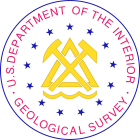
Back هيئة المسح الجيولوجي الأمريكية Arabic Геалагічная служба ЗША Byelorussian Геологическа топографска служба на САЩ Bulgarian যুক্তরাষ্ট্রের ভূতত্ত্ব জরিপ Bengali/Bangla Servei Geològic dels Estats Units Catalan United States Geological Survey Czech United States Geological Survey Danish United States Geological Survey German United States Geological Survey English United States Geological Survey Esperanto
 Seal of the United States Geological Survey | |
 Official identifier of the U.S. Geological Survey | |
 Flag of the United States Geological Survey | |
| Agency overview | |
|---|---|
| Formed | March 3, 1879 (as Geological Survey) |
| Jurisdiction | United States |
| Headquarters | John W. Powell National Center Reston, Virginia, U.S. 38°56′49″N 77°22′03″W / 38.9470°N 77.3675°W |
| Employees | 8,670 (2009) |
| Annual budget | $1.16 billion (FY2019) [1] |
| Agency executive |
|
| Parent agency | United States Department of the Interior |
| Website | USGS.gov |

The United States Geological Survey (USGS) is a scientific agency of the United States government. The agency is a part of the United States Department of the Interior.
The scientists of the USGS study the landscape of the United States, its natural resources, and the natural hazards that threaten it. The organization has four major science disciplines: biology, geography, geology, and hydrology. The USGS is a fact-finding research organization. It has no power to regulate.
The USGS science focus is on seven "Mission Areas", (1) Climate and land use change, (2) Core science systems, (3) Ecosystems, (4) Energy and minerals, (5) Environmental health, (6) Natural hazards, and (7) Water.[3][4]
Administratively, it is divided into a Headquarters unit and six Regional Units.[5] Other specific programs include:
- ↑ H.J.Res. 31
- ↑ "Dave Applegate, Ph.D." U.S. Geological Survey. Retrieved 11 March 2021.
- ↑ "Start with science". United States Geological Survey. Retrieved October 3, 2012.
- ↑ Energy and Minerals Archived 2019-04-01 at the Wayback Machine and Environmental Health Archived 2018-02-18 at the Wayback Machine
- ↑ "Map of geographic areas". Archived from the original on January 15, 2013. Retrieved December 12, 2012.